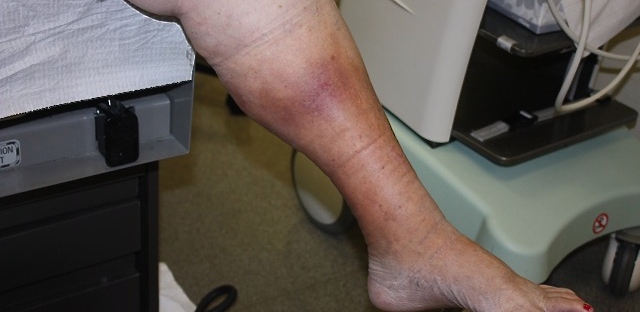Venous Stasis Dermatitis Fort Worth, TX
Venous stasis dermatitis is inflammation of the skin in one or both of the lower legs as a result of longstanding chronic venous insufficiency. Venous insufficiency occurs when veins and their valves are damaged, allowing backward flow of blood in the veins, a condition called venous reflux. Venous reflux produces high pressure in the veins, and has been proven to be the cause of the inflammation in the skin and soft tissue surrounding these diseased veins. Over time this inflammation causes swelling, redness, and eventually fibrosis, or scarring, of the skin and soft tissue. Venous stasis dermatitis is also often associated with brown pigment staining of the skin which worsens the longer the inflammation is present. The medical term for these skin and soft tissue changes is lipodermatosclerosis, or LDS. Most of the time this condition is seen in the lower leg just above the ankle. LDS indicates advanced and chronic (longstanding) venous insufficiency. With further progression of this inflammatory process the skin eventually breaks down with development of an open skin wound, often referred to as a venous ulcer.
Call Today to Schedule Your Appointment
Symptoms of Venous Stasis Dermatitis
- Thin, tissue-like texture of the skin
- Brownish stains on the skin
- Irritation or itching of the skin
- Swollen legs or ankles
- Thickening and hardening of the skin, called lipodermatosclerosis
- Red, crusted or weepy skin
- Cobblestone appearance of the skin
Diagnosis of Venous Stasis Dermatitis
This condition is usually diagnosed by in office examination, but as with other vein disorders ultrasound is often employed to determine the location and extent of the venous insufficiency causing this problem. Additional tests may also be recommended to exclude other diseases.
Treatment of Venous Stasis Dermatitis
Venous stasis dermatitis usually indicates advanced chronic vein disease and needs to be investigated. Ultrasound can usually pinpoint the diseased veins and is useful for diagnosing this condition, and provides the information needed to recommend a treatment plan. It is especially important with this condition to seek medical treatment, because left untreated, venous stasis dermatitis can progress to a non-healing venous ulcer.
Compression therapy is often helpful for the initial treatment of this problem. By reducing the swelling associated with venous stasis dermatitis compression therapy can significantly reduce the inflammation, and improve the health of the involved skin and soft tissue temporarily. However, the underlying cause of the inflammation in venous stasis dermatitis is almost always valve failure in the veins leading to sluggish bloodflow. Most of the time this occurs in the superficial veins of the leg, which is important because the diseased superficial veins can be treated in the office with minimally invasive procedures with an excellent long-term outcome.
You can read more about these minimally invasive procedures under the Treatment tab on the home page. Click on the endovenous radiofrequency ablation and ultrasound guided sclerotherapy tabs for more information.
*The information about Venous Stasis Dermatitis was reviewed by Board Certified Surgeon Dr. Michael Darnell. If you have any questions, please don’t hesitate to contact us using our contact form.

